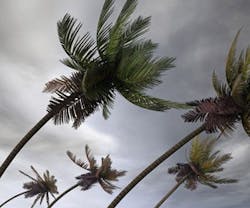New Study Examines Shingle Performance in Hurricanes
The Institute for Business & Home Safety (IBHS) released its latest research study, “Surviving Nature’s Fury: Performance of Asphalt Shingle Roofs in the Real World,” which investigated damage from Hurricanes Gustav and Ike in 2008. Roof cover damage is the most frequent source of hurricane-related insurance claims not related to storm surge. The findings examined how well asphalt shingle roofs perform during a hurricane.
“IBHS’ analysis examined damage levels at relatively low wind speeds as a function of the age of the roof, the adoption and enforcement of modern building codes, and investigated the validity of questions concerning whether the current approach to the design of shingles that reduces uplift loads is adequate,” said Timothy Reinhold, IBHS’ senior vice president of research and chief engineer.
The study uncovered several key findings:
- Damage occurred even in fairly light winds – peak gust wind speeds were less than 90 mph in the areas where houses were studied. This demonstrates that it does not take a major hurricane with high wind speeds to substantially damage a roof.
- A significant number of roofs installed between 1998-2001 experienced damage of up to 5% of the roof area. However, damage dropped dramatically for roofs built after 2002. It is possible that the newness of the roof covers or building code changes in 2002, which added a check for roof cover wind rating, could account for this drop.
- Newer shingle roofs installed after the Texas Department of Insurance adopted the 2000 International Building Code in February 2003 exhibited much less wind damage from the wind speeds produced by Hurricane Ike than older roofs in the same area. This could be attributed to a combination of age and code/product changes.
“This study just begins to address the issues associated with shingle performance in high winds,” said Reinhold. “More research is needed both in terms of field investigations for events, where new wind-rated products are exposed to higher wind speeds, and in a controlled environment, where effects of aging and wind speed can be investigated on demand for a variety of products.”
The full version of the study is available in the summer issue of IBHS’ Disaster Safety Review: http://www.disastersafety.org/resource/resmgr/PDFs/DSR_summer_2010_web.pdf
